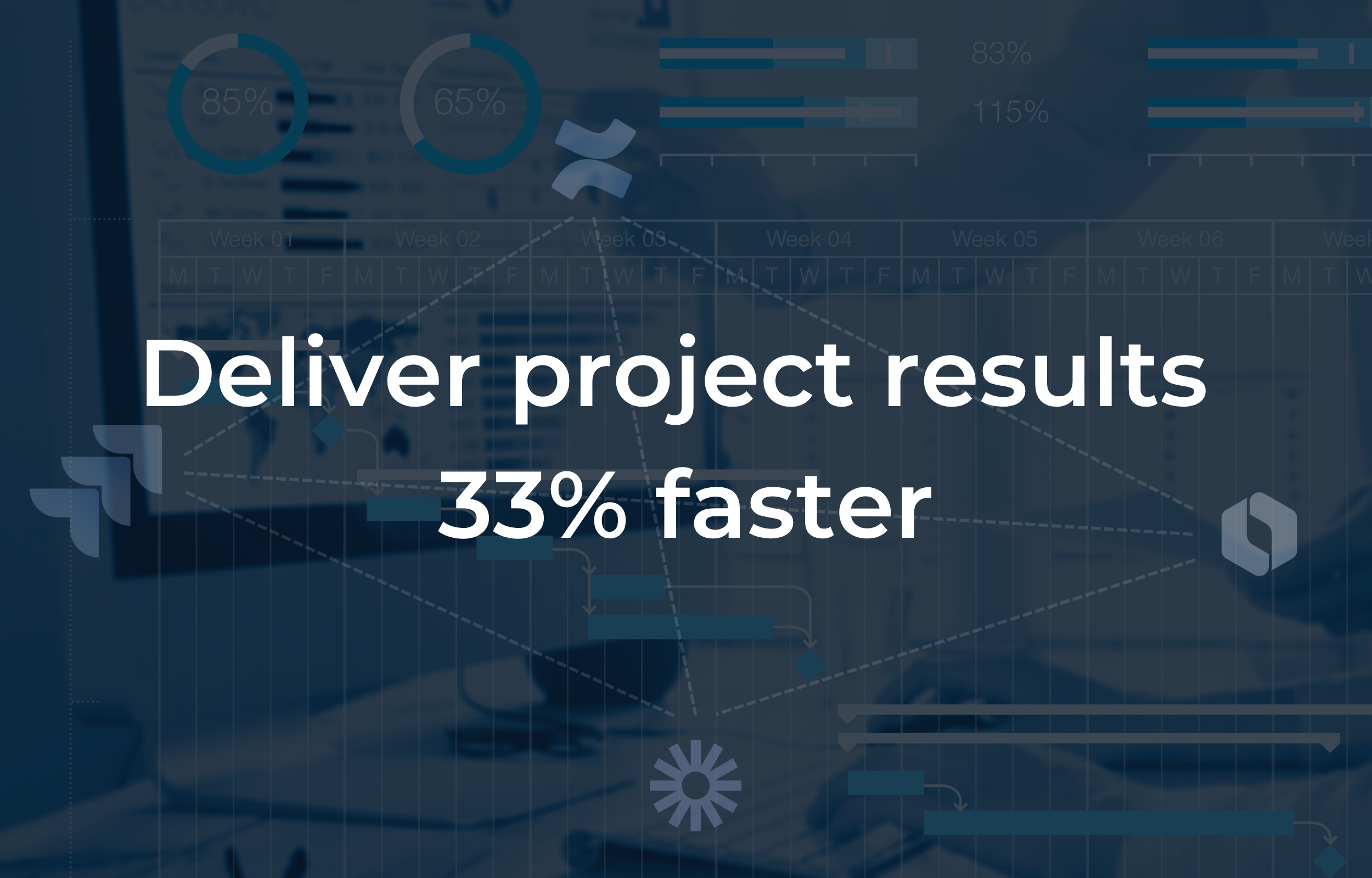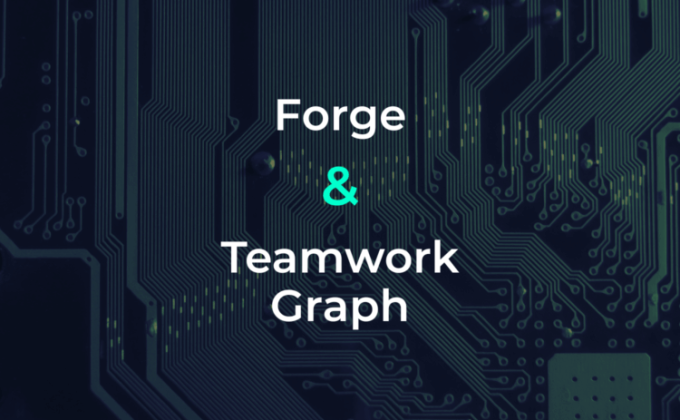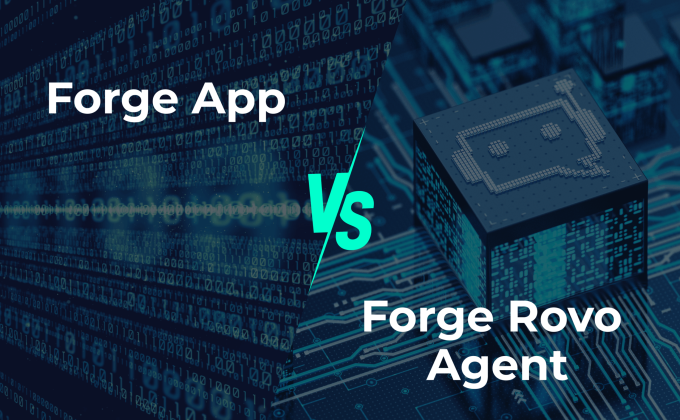Have you had enough of confusing tools and fragmented projects? Teams that often work together on a project basis juggle numerous tasks on a daily basis: they coordinate distributed colleagues, manage deadlines and fight against information silos.
A recent study by the Enterprise Strategy Group (ESG) shows how much an integrated work management platform can reduce these hurdles. In the following, we first outline the most common stumbling blocks in everyday project work and then present possible solutions.
Everyday challenges in project management
Permanent interruptions and context changes
Every ad hoc request, every tool change takes the team out of the workflow. According to ESG, there are an average number of 21 irrelevant interruptions per employee per week,which costs valuable time and focus.
Information silos and high search effort
Project knowledge is often spread across emails, chat histories and folder structures. Challenging for individual employees, but a nightmare for newcomers. ESG analyses show that employees spend up to 40% of their time looking for the information they need.
Tool proliferation
Many organizations use six or more collaboration tools in parallel. This not only makes work more difficult because you have to switch between different tools to carry out certain work steps. It is also associated with rising license and security costs. Up to 40% of the IT budget is spent on subsequent corrections to fragmented systems.
Lack of reusability
What was it like with a similar project from the previous year? This question comes up regularly in kick-off meetings. Without central templates and a lessons learned database, every project starts from scratch. This leads to recurring errors and extends project durations by an average of 25%.
Long onboarding phases
New team members often need four months to become really productive. They have to learn which tool is used for which purpose and in how many different places which information is stored. A standardized platform can halve this phase to around 2.4 months, quickly freeing up hundreds of hours of additional productivity.
The solution: An integrated work management platform for project coordination and teamwork
A single, connected environment seamlessly links tasks, documents and status updates from the initial idea to the final report. It is the basis for implementing the following success factors for efficient teamwork.
Standardized workflows and automation
Project templates bundle best practices into reusable workflows. Instead of structuring every task from scratch, the team uses tried and tested steps, from the initial requirements to acceptance. Automations (e.g. via Atlassian Rovo) take over routine tasks such as:
- Status change notifications only when real progress is made
- Due date reminders only to parties involved
- Automatic creation of subtasks
Benefit & effect:
- Interruptions are reduced by up to 35% because annoying queries are eliminated.
- Teams start projects 25% faster because the planning phase is clearly defined and immediately available.
Central knowledge and document management
All relevant documents, from specifications to meeting minutes, end up in a single, searchable hub (e.g. Confluence from Atlassian). Full-text search and AI-supported summaries make it possible to access important details within seconds. Historical projects can be accessed at any time via "Lessons Learned" pages.
Benefit & effect:
- Research times are halved, freeing up hundreds of thousands of hours of productivity every year.
- New colleagues find all the important information more quickly during the induction phase 40% and are productive after 2.4 instead of 4 months.
Real-time transparency for all stakeholders
Live dashboards and automated status feeds give project managers a clear overview of progress, risks and capacity utilization at all times. They show current status data at all times:
- Which task is located where?
- Which risks are increasing?
- How is the utilization of individual teams?
Automatically generated status feeds only inform stakeholders when there is a real need for action.
Benefit & effect:
- Decisions can be made up to one hour faster per team member per week.
- Coordination meetings are required less frequently, as everyone involved is always on the same level of information.
Continuous improvement and governance
Project blueprints and checklists are maintained centrally. Approved variants are available to all teams, including
- Prefabricated risk management check
- Standardized review loops
- Automatically documented change tracking
Benefit & effect:
- Errors in the process are reduced by around 18%.
- PMO leads gain control over governance processes and can fulfill compliance requirements more easily.
- The "blank page" problem that every project starts from scratch is solved.
Scalable onboarding & team alignment
New team members go through an integrated onboarding process:
- Automatically assigned training tasks
- Linked knowledge tracker for quick guides and SOPs
- Real-time mentoring feeds that inform managers when issues remain unresolved
Benefit & effect:
- Time-to-productivity decreases from 4 to 2.4 months and saves over 30 FTE months per 100 new hires.
- A uniform understanding of processes strengthens cross-divisional cooperation.
Use case: Faster time to market for software features thanks to Atlassian Teamwork Collection
The Atlassian Teamwork Collection offers an app bundle for project teams that fulfills the requirements of a modern work management platform.
Now imagine the following scenario: Your team is planning the launch of a new software feature. Without an integrated environment, the participants jump back and forth between emails, chat tools and various project apps, status updates trickle in through different channels, and coordination meetings drag on. We now use the apps from the Atlassian Teamwork Collection, Confluence, Jira, Rovo and Loom, in a targeted manner:
1. Idea and framework planning in Confluence & Rovo
The team starts in Confluence with a central page on which stakeholders compile requirements, user stories and competition analyses. Thanks to structured page templates, all relevant points such as goals, risks and timelines are visible at a glance.
Parallel to this Rovo's chat assistant to ask about comparable project plans or to summarize existing Confluence pages at lightning speed. For example, if you want to know how previous marketing releases went, type a query into Rovo and immediately receive relevant links and insights - without any manual searching.
Challenge solved: Information silos and long search times.
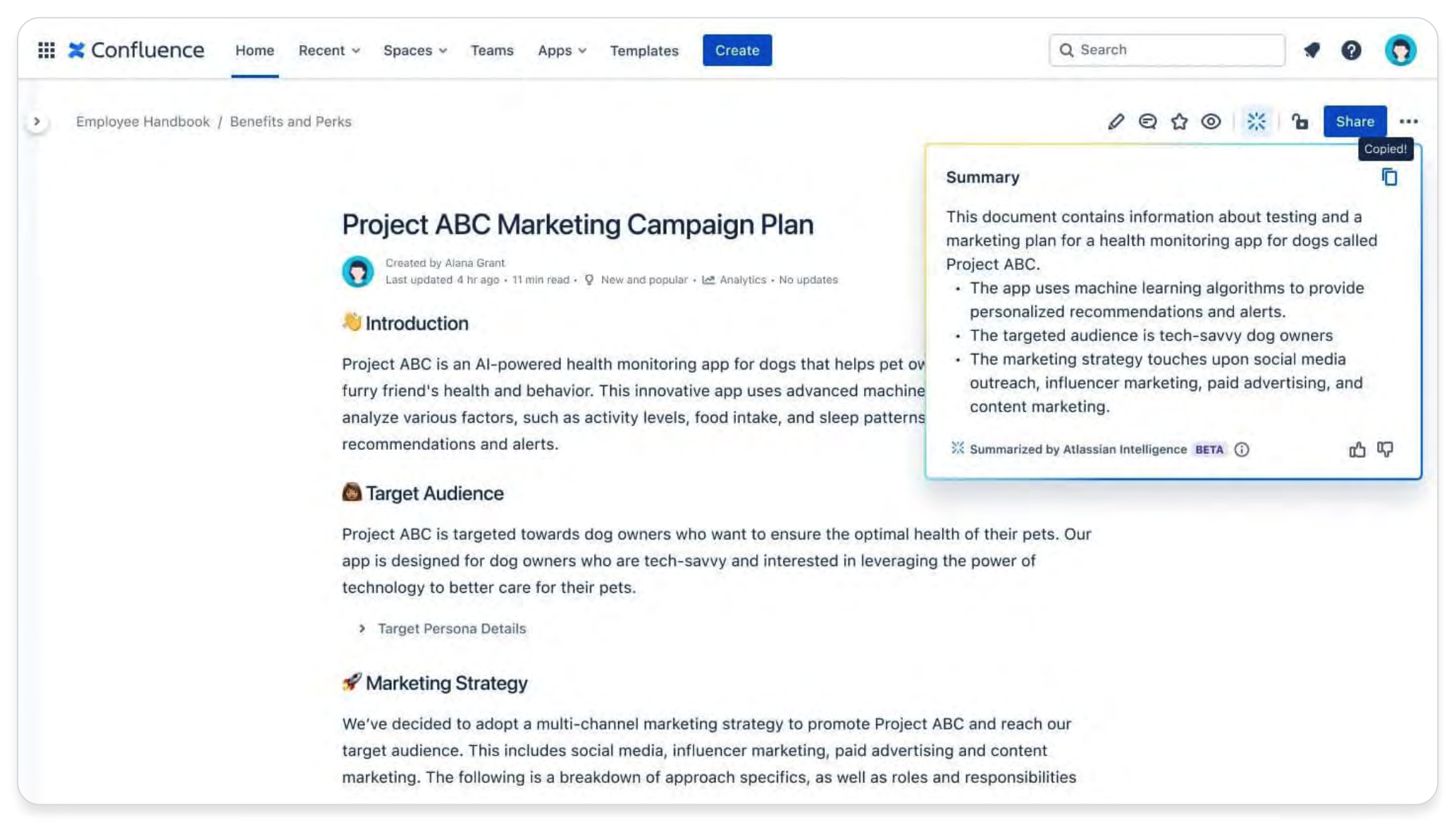
2. Detailed planning and tracking in Jira & Rovo
Jira tickets are automatically created from Confluence stories using the "Create Issue" link. These can be assigned to a defined company goal using the Goals app in order to transparently show which goal this project supports.
The Rovo Agent can also start automated workflows: Create new tasks, automatically notify QA as soon as a story enters the review stage and create weekly progress reports. This eliminates the need for repeated status pings and allows the team to maintain an overview without leaving the board.
Challenge solved: Interruptions due to status queries and inconsistent processes.
3. Team alignment and progress overview in Rovo & Jira
All Jira data flows together live in Rovo's dashboard view - burndown charts, open blockers, capacity bottlenecks. These metrics can be embedded in Confluence pages via a chat prompt or briefly explained directly via Loom video. Product managers can thus recognize early on when the QA team is building up a backlog and can proactively take corrective action.
Challenge solved: Unclear capacity planning and lack of real-time transparency.
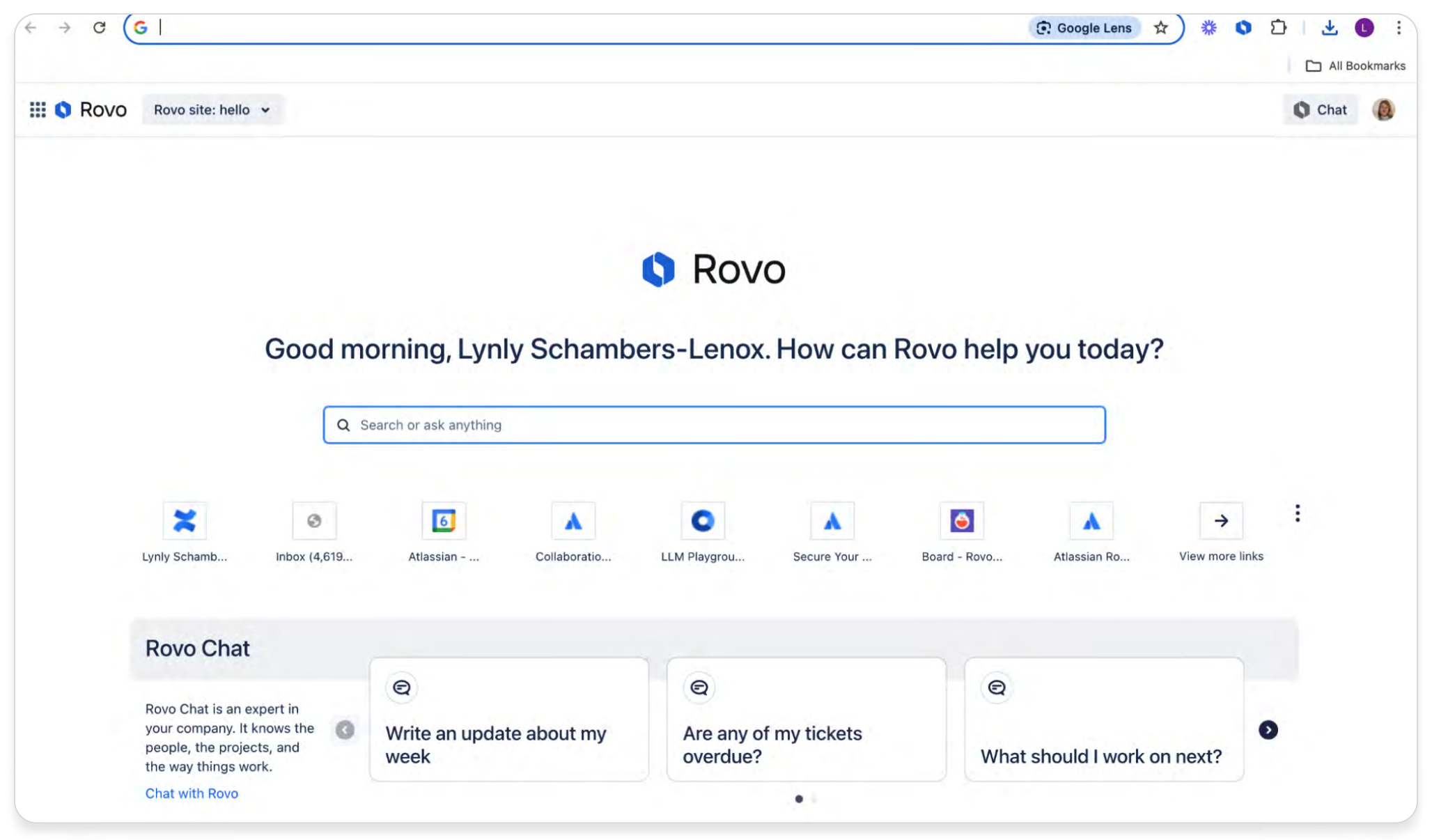
4. Asynchronous updates and training with Loom & Rovo
Developers create short Loom clips for deploy instructions or architecture walkthroughs. The Loom video is linked directly in a Jira ticket or the linked Confluence page. Rovo can read the content of the videos so that new and existing team members can always find the latest learning resources via Rovo chat and without any manual tagging.
Challenge solved: Long onboarding phases and recurring standard training courses.
5. Go-live and feedback loop
Shortly before the rollout, the PMO team summarizes the lessons learned in Confluence. Rovo Agents automatically export the relevant Jira comments and Loom Insights into a compact final report for management. The updated project blueprints are then stored centrally and are immediately available for the next release.
Results: The close integration of Confluence (knowledge hub), Jira (task management), Rovo (search & automation) and Loom (video communication) reduces the time-to-market by around 25 %, interruptions are reduced by 35 % and the team gains valuable capacity for follow-up projects.
Conclusion: Integrated work management platforms accelerate project runtimes
The ESG study impressively proves that an integrated work management platform, such as Atlassian's, creates clear processes, minimizes interruptions and accelerates project lead times.
For PMO leads, this means less operational effort, more strategic freedom and visible productivity effects.
Do you know where your Team Quick Wins are due to consolidation?
Our Atlassian experts will be happy to help you identify the areas of application of the Teamwork Collection with the greatest possible potential. Talk to us without obligation.
